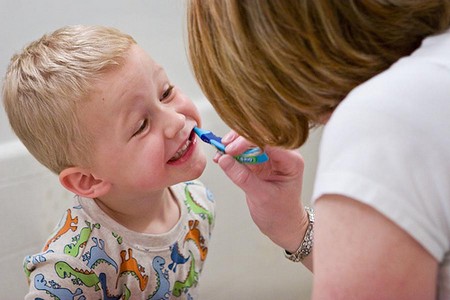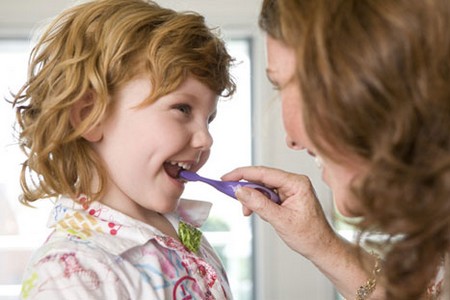Best Way to Encourage a Child to have a Good Dental Habit
Every tooth consists of an outer coat of hard, dead enamel and an inner core of soft, live dentine. We start to feel a toothache when decay is so severe that it bores its way through the enamel into the inner living core. Dental care, therefore, is very important for your children.
While occasionally a baby is born with a tooth, most babies don’t have their first tooth until around six months, although some children don’t get their first tooth until they are at least a year old. This first set of teeth (known as baby teeth) is found in girls earlier than in boys, but boys tend to lose their baby teeth earlier. All twenty baby teeth are already formed at birth. You may be able to feel them as bumps in your baby’s gums before they actually break through.
The teething stage (when your baby’s teeth begin to erupt through his gums) can cause your baby extreme discomfort. You may notice he salivates a lot, or chews hard on his rattles. In many instances, a teething baby has red cheeks, diarrhea, and even a rash on his bottom. Be careful not to attribute every ailment at this stage to teething, since another cause may be responsible for your baby’s distress. You may be able to ease your baby’s discomfort by gently massaging the gum area with your clean finger. Some parents recommend giving the baby something hard and cold to chew on, such as a cooled teething ring.
Baby teeth are particularly vulnerable to decay, which is why you should avoid giving your infant sweet drinks and foods. His first teeth should be treated with care, as they lay the foundation for subsequent healthy jaw and gum growth. They also guide the second teeth into place.
From the age of five, your child’s baby teeth will begin to loosen and fall out, usually in the front lower jaw first. You may be able to see the second tooth as soon as the baby tooth comes out. And by the time your child is seven, a good many of his first teeth will have fallen out—ask a group of children this age to smile, and you’ll have great difficulty counting all the gaps between their teeth! The legend of the generous tooth fairy comes to the fore at this point. Although your child may have a hunch that, in reality, you are the tooth fairy, he’ll be quite willing to push these doubts to the back of his mind as he savors the prospect of finding a coin in place of the tooth he left under his pillow the night before.
Since dental care is so important, introduce your child to toothbrushing as soon as his baby teeth appear. At first, simply let him chew on a small, soft toothbrush, and let him watch as you brush your teeth in the morning. This sets a good example. Don’t let your child use toothpaste until he learns to spit, not swallow. Then make sure the toothpaste contains fluoride, and ask your dentist’s advice on the proper technique for brushing teeth (regular dental appointments should be made when your child is three or four years old). Good brushing does not involve scrubbing the teeth as hard as possible—rather, you should be gentle, but thorough. When your child reaches the toddler stage, make toothbrushing a regular routine after mealtimes and before bedtime. Never let your child have sweet products, juices, or milk in his mouth once he has brushed his teeth at night.

Despite your best intentions about not letting your child develop a sweet tooth, chances are he will want to eat more candy than you would like. Try to reach a balance on this. If you forbid him to have any candy, he will probably get some from his friends. The best strategy is to give your child candy or dessert after a meal and just before he brushes his teeth. His teeth are most at risk from decay when he eats a small number of candies throughout the day than when he eats a large number all at once.
Categories
Advertisements
Recent Articles
 How to Understand Bed Sizes – A Small Guide
How to Understand Bed Sizes – A Small Guide How to Select Some Must Have Kitchen Accessories
How to Select Some Must Have Kitchen Accessories Best Way to Change a Car Tire
Best Way to Change a Car Tire Best Way to Write an Affirmation
Best Way to Write an Affirmation Best Way to Take Charge of Your Financial Life
Best Way to Take Charge of Your Financial Life Best Way to Survive a Party When You Don’t Know Anyone
Best Way to Survive a Party When You Don’t Know Anyone Best Way to Stop Self Sabotaging Yourself
Best Way to Stop Self Sabotaging Yourself Best Way to Start Journal Writing
Best Way to Start Journal Writing Best Way to Speak with a Powerful Voice
Best Way to Speak with a Powerful Voice Best Way to Simplify Your Life
Best Way to Simplify Your Life Best Way to Respond to a Put-Down
Best Way to Respond to a Put-Down Best Way to Reduce Acne Breakouts
Best Way to Reduce Acne Breakouts Best Way to Recover from Dining Disasters
Best Way to Recover from Dining Disasters Best Way to Quit Your Job Gracefully
Best Way to Quit Your Job Gracefully Best Way to Make Your Own Website
Best Way to Make Your Own Website


Leave a Reply